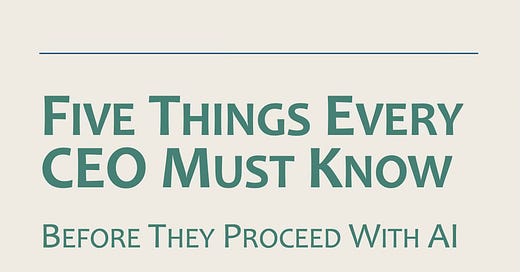In conversations with CEOs and business leaders, not just in the US but around the world, it's becoming clear that, while everyone is talking about AI, the gap is widening between leaders who are already adopting AI and laggards who are still hesitant.
This is not a new story. I have seen it repeated with numerous new technologies as they appear; the adoption of the internet and, later, mobile devices followed a similar pattern. But not quite so dramatically.
There are two closely related risks.
Some companies are rushing impetuously to implement AI without first building the organizational foundations they need. They're treating AI as the ultimate technical upgrade rather than as a fundamental reimagining of how we work, create value, and serve our customers. They may be leading in tech, but some are rushing into difficulty.
Other organizations are hesitant because they don't know where and how to start. To be fair, they are not resisting progress; they may see even greater potential for AI than the leaders who are pushing ahead. But they are not at all sure how to get started confidently.
This realization led me to write my latest whitepaper, where I identify five critical factors that separate successful AI implementations from costly experiments.
These elements of success are overlooked in the rush to "do something with AI," but they consistently determine the difference between transformation and expensive disappointment. They are also the foundations of getting started for companies that are hesitant.
Beyond the Technical Hype
With executive teams, I often find they've jumped straight to selecting AI tools and platforms to solve their immediate problems without first answering fundamental questions about their organization's readiness, culture, and strategic objectives. The attitude seems to be that AI will make them innovative, and organizational change will follow.
However, one thing I have learned over the last decade when I have been focused on innovation strategy, is that thinking about innovation as problem-solving is very limiting. Traditional innovation frameworks, focussed on problems and their solutions, often limit AI's potential to fix inefficiencies. The organizations that see the best results are those that have shifted their mindset from problem-solving to possibility-creating.
They're asking not What can AI fix? but What could AI make possible? The distinction might seem subtle, but the implications for implementation and outcomes are significant.
That's just one of the five critical areas I explore in depth in the paper.
The Hidden Costs of AI Implementation
Another common issue in IT strategy of all kinds is that many organizations meticulously budget for technology but often overlook even more significant operational and organizational costs. This happens with software licenses and cloud computing resources, and it's happening with AI tools.
However, even more than earlier technologies, AI is driving its own fundamental changes in how teams work, how decisions are made, and how value is created.
I'm seeing too many promising AI projects falter, not because of technical issues but because organizations weren't prepared for the full scope of the transformation they were bringing on themselves.
So, another topic in the whitepaper is the need to understand the true cost of AI adoption. This goes beyond traditional ROI calculations to include critical factors like data readiness, team capabilities, change management, and ongoing governance requirements.
Executive Literacy
Obviously, your next step should be to read the whitepaper: you can download it from my website. But there is still one more piece of advice I can share here.
AI literacy at the executive level isn't optional anymore. Gone are the days when leaders could delegate technology decisions entirely to the office of the CTO or CIO. The strategic implications of AI are too profound, and the risks of misalignment are too costly for CEOs to remain on the sidelines of these decisions, which may be pretty technical.
That's why my colleague John Santaferraro and I have developed specific workshops and engagement models focused on building executive AI literacy. These aren't technical deep dives into the algorithms. Instead, they're carefully crafted sessions that help leaders understand the language of AI, the strategic implications and the opportunities. Our AI Literacy for Executives workshop, for instance, makes the difference between reading about AI and successfully planning for it.
This matters because the most successful AI implementations share one common feature: leaders who understand enough about AI to ask the right questions and make informed strategic decisions.
So, the whitepaper is both a strategic framework and a practical roadmap. Whether you're just beginning to explore AI's potential or looking to accelerate existing initiatives, download the complete whitepaper and prepare yourself for what comes next.





